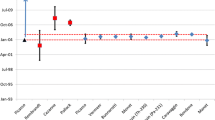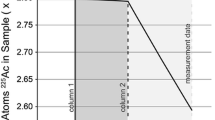Abstract
We present a novel age-equation calibration for fission-track age determinations by laser ablation inductively coupled plasma mass spectrometry. This new calibration incorporates the efficiency factor of an internal surface, [ηq]is, which is obtained by measuring the projected fission-track length, allowing the determination of FT ages directly using the recommended spontaneous fission decay constant. Also, the uranium concentrations in apatite samples are determined using a Durango (Dur-2, 7.44 μg/g U) crystal and a Mud Tank (MT-7, 6.88 μg/g U) crystal as uranium reference materials. The use of matrix-matched reference materials allows a reduction in the uncertainty of the uranium measurements to those related to counting statistics, which are ca. 1 % taking into account that no extra source of uncertainty has to be considered. The equations as well as the matrix-matched reference materials are evaluated using well-dated samples from Durango, Fish Canyon Tuff, and Limberg as unknown samples. The results compare well with their respective published ages determined through other dating methods. Additionally, the results agree with traditional fission-track ages using both the zeta approach and the absolute approach, suggesting that the calibration presented in this work can be robustly applied in geological context. Furthermore, considering that fission-track ages can be determined without an age standard sample, the fission-track thermochronology approach presented here is assumed to be a valuable dating tool.




Similar content being viewed by others
References
Barbarand J, Carter A, Hurford T, Wood I (2003) Compositional and structural control of fission-track annealing in apatite. Chem Geol 198:107–137
Carter A and Gallagher K (2004) Characterising the significance of provenance on the inference of thermal history models from apatite fission track data—a synthetic data study. In: Bernet M and Spiegel C (eds) Detrital thermochronology—provenance analysis, exhumation, and landscape evolution of mountain belts, GSA Special Paper, 378, p 7–23
Chew D, Donelick RA (2012) Combined apatite fission track and U-Pb dating by LA-ICP-MS and its application in apatite provenience analysis, Mineralogical Association of Canada Short Course 42, Ts. John’s NL, 219–247
Donelick RA, O’Sullivan PB, Ketcham RA (2005) Apatite fission-track analysis. Rev Mineral Geochem 58:49–94
Eggins SM, Kinsley LK, Shelley JMG (1998) Deposition and element fractionation processes occurring during atmospheric pressure laser sampling for analysis by ICPMS. Appl Surf Sci 127–129:278–286
Enkelmann E, Jonckheere R, Wauschkuhn B (2005) Independent fission-track ages (ϕ-ages) of proposed and accepted apatite age standards and a comparison of ϕ-, Z-, ζ- and ζ0-ages: implications for method calibration. Chem Geol 222:232–248
Enkelmann E, Jonckheere R (2003) Correction factors for systematic errors related to the track counts in fission-track dating with external detector method. Radiat Meas 36:351–356
Hadler JC, Iunes PJ, Kawashita K, Guedes S, Tello CA, Paulo SR (2003) Dating by fission track method substituting the nuclear reactor by an ICPMS. In: South american symposium on isotope geology. Salvador, Brazil, pp 77–80
Hadler JC, Iunes PJ, Tello CA, Chemale F, Kawashita K, Curvo EAC, Santos FGS, Gasparini TE, Moreira PAFP, Guedes S (2009) Experimental study of a methodology for fission-track dating without neutron irradiation. Radiat Meas 44:955–957
Hasebe N, Barbarand J, Jarvis K, Carter A, Hurford A (2004) Apatite fission-track chronometry using laser ablation ICP-MS. Chem Geol 207:135–145
Hasebe N, Carter A, Hurford A, Arai S (2009) The effect of chemical etching on LA-ICP-MS analysis in determining uranium concentration for fission-track chronometry. Thermochronological method: from paleotemperature constraints to landscape evolution model. Geological society, London, special publication, 324, 37–46
Hiess J, Condon DJ, McLean N, Noble SR (2012) 238U/235U systematics in terrestrial uranium-bearing minerals. Science 335(6076):1610–1614
Holden NE, Hoffman DC (2000) Spontaneous fission half-lives for ground-state nuclides (technical report). Pure Appl Chem 72:1525–1562
Jochum KP, Nohl U, Herwig K, Lammel E, Stoll B, Hofmann AW (2005) GeoReM: a new geochemical database for reference materials and isotopic standards. Geostand Geoanal Res 29:333–338
Jochum KP, Stoll B, Herwig K, Willbold M (2007) Validation of LA-ICP-MS trace element analysis of geological glasses using a new solid-state 193 nm Nd:YAG laser and matrix-matched calibration. J Anal At Spectrom 22:112–121
Jochum KP, Weis U, Stoll B, Kuzmin D, Yang Q, Raczek I, Jacob DE, Stracke A, Birbaum K, Frick DA, Günther D, Enzweiler J (2011) Determination of reference values for NIST SRM 610-617 glasses following ISO guidelines. Geostand Geoanal Res 35:397–429. doi:10.1111/j.1751-908X.2011.00120.x
Jonckheere R, Van den Haute P (2002) On the efficiency of fission-track counts in an internal and external apatite surface and in a muscovite external detector. Radiat Meas 35:29–40
Jonckheere R (2003) On the densities of etchable fission tracks in a mineral and co-irradiated external detector with reference to fission-track dating of minerals. Chem Geol 200:41–58
Klemme S, Prowatke S, Münker C, Magee CW, Lahaye Y, Zack T, Asemann SA, Cabato EJA, Kaeser B (2008) Synthesis and preliminary characterisation of new silicate, phosphate and titanite reference glasses. J Geostand Geoanal 32:39–54
Kraml M, Pik R, Rahn M, Selbekk R, Carignan J, Keller J (2007) A new multi-mineral age reference material for 40Ar/39Ar, (U-Th)/He and fission-track method: the Limberg t3 tuff. Geostand Geoanal Res 30:73–86
Lanphere MA, Baadsgaard H (1997) The Fish Canyon Tuff: a standard for geochronology. EOS Trans Am Geophys Un 78:5326
Lederer CM, Shirley VS (1978) Table of Isotopes, 7th edn. Wiley, New York, USA, p 1523
McDowell DD, McIntosh WC, Farley KA (2005) A precise 40Ar–39Ar reference age for the Durango apatite (U–Th)/He and fission-track dating standard. Chem Geol 214:249–263
Pouchou JL, Pichoir F (1984) A new model for quantitative X-ray-microanalysis. Part I: applications to the analysis of homogeneous samples. Recherche Aerospatiale 3:13–38
Shen C, Donelick RA, O’Sullivan PB, Jonckheere R, Yang Z, She Z, Miu X, Ge X (2012) Provenance and hinterland exhumation from LA-ICP-MS zircon U-Pb and fission-track double dating of Cretaceous sediments in the Jianghan Basin, Yangtze block, central China. Sediment Geol 281:194–207
Soares CJ, Guedes S, Tello CA, Lixandrão-Filho AL, Osório AM, Alencar I, Dias ANC, Hadler J (2013) Further investigation of the initial fission-track length and geometry factor in apatite fission-track thermochronology. Am Mineral 98:1381–1392
Tello CA, Hackspacher P, Hadler JC, Iunes PJ, Guedes S, Paulo SR, Ribeiro LF (2003) Recognition of Cretaceous, Paleocene and Neogene Tectonic Reactivation, through apatite fission-track analysis, in Precambrian areas of the southeast Brazil: association with the South Atlantic Ocean opening. J S Am Earth Sci 15:765–774
Tello CA, Hadler JC, Iunes PJ, Guedes S, Hackspacher PC, Ribeiro LF, Paulo SR, Osório AM (2005) Thermochronology of the South American platform in the State of São Paulo, through apatite fission tracks. Radiat Meas 39:635–640
Wagner GA, Van den Haute P (1992) Fission-track dating. Kluwer, Dordrecht, p 285
Acknowledgments
This work was founded by Fundação de Amparo à Pesquisa do Estado de São Paulo (FAPESP, Brazil) and Conselho Nacional de Desenvolvimento Científico e Tecnológico (CNPq, Brazil). The authors thank Dr. Richard Ketcham and an anonymous reviewer for their comments and suggestions which helped to improve this manuscript. We thank Dr. Eleanor Green for helping with language editing. Finally, we thank Dr. Raymond Jonckheere for providing the Limberg sample.
Author information
Authors and Affiliations
Corresponding author
Rights and permissions
About this article
Cite this article
Soares, C.J., Guedes, S., Hadler, J.C. et al. Novel calibration for LA-ICP-MS-based fission-track thermochronology. Phys Chem Minerals 41, 65–73 (2014). https://doi.org/10.1007/s00269-013-0624-2
Received:
Accepted:
Published:
Issue Date:
DOI: https://doi.org/10.1007/s00269-013-0624-2




